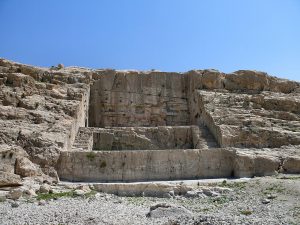Qadamgāhقدمگاه
Location: Qadamgāh is a rock-cut monument in the region of Persepolis in southern Iran, Fars Province.
29°44’1.79″N 53°12’44.67″E
Map
Historical Period
Achaemenid/Post-Achaemenid
History and description
Qadamgāh is a rock-cut monument at the southeastern end of the Kuh-e Raḥmat, 40 km south of Persepolis. The structure is hewn from the cliff by cutting three superimposed platforms (fig. 1). Each terrace is 13.50 m. wide. The lower terrace stands 3 meters above the ground. The upper terrace is approximately 7 meters high and is accessed by means of two rock-cut staircases on each side. There are two rows of five square niches or holes on the rocky surface of the structure. The structure has been dated, tentatively, to the Achaemenid/Post-Achaemenid period. As regards its function, several suggestions have been made: another unfinished tomb (like the one attributed to Darius III near Persepolis), a ritual function, or a cultic function in connection with water.
Archaeological Exploration
Captain Henry Lake Wells of the Royal Engineers in 1881. Without describing it, Wells published a drawing of the plan and section of the structure. In 1952, Louis Vanden Berghe published a thorough description of the roc-cut monument and suggested that it might be an open-air cultic structure related to the nearby spring. Muammad-Taqi Mostafavi proposed a funerary function such as an unfinished royal tomb. In his 1993 article, Wolfram Kleiss compared the monument at Qadamgāh with astodans. No archaeological excavation has ever been done in the whereabouts of the rock-cut monument. Jean-Claude Bessac re-examined the monument in 2005 and concluded that it had been completed since the lower portions, which were the most recent parts to be completed by the masons, had been polished down.
Bibliography
Bessac, J.-C., “Lecture technique et interprétations du monument rupestre de Qadamgah (Fars),” Iranica Antiqua, vol. 42, 2007, pp. 185-206.
Boucharlat, R., “Le monument rupestre de Qadamgah (Fars): essai d’interprétation,” Iranica Antiqua, vol. 14, 1979, pp. 153-166.
Boucharlat, R., “Qadamgāh,” Encyclopaedia Iranica Online, © Trustees of Columbia University in the City of New York
Kleiss, W., “Bemerkungen zur Felsanlage Qadamgah am Kuh-i Rahmat Südöstlich von Persepolis,” Archaeologisches Mitteilungen aus Iran, vol. 26, 1993, pp. 161-164, pls. 51-53.
Mostafavi, M. T., The Land of Pārs, Chippenhamn Wilts, 1978, pp. 27-28.
Schippmann, K., Die Iranischen Feuerheiligtümer, Berlin, 1971, pp. 167-169.
Vanden Berghe, L., “Monuments récemment découverts en Iran méridional,” Bibliotheca Orientalis, vol. 10, 1953, pp. 7-8, pls. V-VI, figs. 10 and 12.
Vanden Berghe, L., L’archéologie de l’Iran ancien, Leiden, 1957, p. 45, fig. 10.
Vanden Berghe, L., On the Track of the Civilizations of Ancient Iran, Memo from Belgium, No. 104-105, September-October 1968, p. 34.
Wells, H. L., “Surveying Tours in Southern Persia. A Journey Round Lake Neris,” Proceedings of the Royal Geographical Society, vol. 5, 1883, pp. 143-144.
Author: Ali Mousavi
Originally published: March 4, 2022
Last updated: January 13, 2025


































































































































